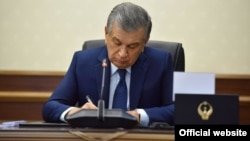Uzbekistan’s President Shavkat Mirziyoev has issued a decree to hasten the full transition of the Uzbek language from the Cyrillic to Latin alphabet.
The decree issued on October 21 outlines language policy for the 2020-30 period as the Central Asian country continues an on-again, off-again attempt to reform the Uzbek language and widen its use.
One pillar of the decree calls on the government to create a working group within three months to develop and submit to the presidential administration a road map for a full transition to the Uzbek alphabet based on the Latin alphabet.
Another part calls on government officials by April 2021 to be certified in their knowledge of Uzbek.
The document also states that by 2030, 80 percent of kindergartners should be Uzbek-speaking. It also aims to increase the hours of Uzbek language teaching.
Uzbek was written in an Arabic script until the late 1920s, then switched to Latin script as part of a larger Latinization of Turkic languages, before the Soviets introduced Cyrillic in 1940.
In the early 1990s, the newly independent state of Uzbekistan began to transition back to Latin script but Cyrillic is still widely used.
After going through various iterations, a working group at Tashkent State University presented a final draft of the updated Uzbek alphabet based on the Latin alphabet in 2019.
The linguists’ updated alphabet consists of 30 characters: 29 letters and an apostrophe to denote a hard sign.
In neighboring Kazakhstan, the process of switching to the Latin alphabet has been going on since 2017, when former President Nursultan Nazarbaev first instructed the government to draw up a timetable for the transition of the Kazakh alphabet to the Latin alphabet.
In both Uzbekistan and Kazakhstan, the move to shift to Latin script is in part driven by political considerations in order to distance the Central Asian states from years of Russian influence and develop a stronger national identity in the young states. The Latin script is also considered better suited to Turkic languages.
The Soviet-era transition of Turkic languages to Cyrillic was in part implemented to distance Central Asian states and Azerbaijan from Turkey, which as part of a Westernization drive changed its Persian-Arabic script to a Latin one in the 1920s.
The switch away from Arabic script among Turkic languages was designed to distance Turkey and Muslim Central Asian nations from the Islamic world.
Uzbekistan Moves To Quicken Transition To Latin Alphabet

Editors' Picks
RFE/RL has been declared an "undesirable organization" by the Russian government.
If you are in Russia or the Russia-controlled parts of Ukraine and hold a Russian passport or are a stateless person residing permanently in Russia or the Russia-controlled parts of Ukraine, please note that you could face fines or imprisonment for sharing, liking, commenting on, or saving our content, or for contacting us.
To find out more, click here.
Top Trending Central Asia
1









